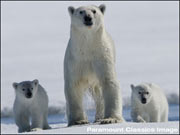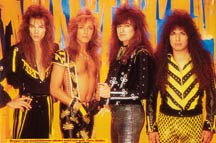 Before we get started, let’s clear up some misconceptions: Arctic Tale is not the sequel to “An American Tail,” so don’t look for an appearance by Feivel Mousekewitz. And it’s not about penguin migration as narrated by Morgan Freeman. Instead, we get two other animal protagonists, not animated in the comic-drawn sense: Seela, a walrus and Nanu, a polar bear. How does storyteller/narrator Queen Latifah know their names? That’s why she’s the Queen.
Before we get started, let’s clear up some misconceptions: Arctic Tale is not the sequel to “An American Tail,” so don’t look for an appearance by Feivel Mousekewitz. And it’s not about penguin migration as narrated by Morgan Freeman. Instead, we get two other animal protagonists, not animated in the comic-drawn sense: Seela, a walrus and Nanu, a polar bear. How does storyteller/narrator Queen Latifah know their names? That’s why she’s the Queen.
Since Seela and Nanu are natural enemies, this is no buddy tale of two rascally animals who leave their packs to seek their fortunes together. Instead, we see two young female animals being shepherded through the early stages of life (through adolescence) by their mothers while their arctic environment melts around them. Nanu’s mother raises her and her “unfocused” brother, teaching them to hunt seals through layers of ice and snow. Seela’s mother and aunt teach her to climb onto patches of ice and protect her from predators. It is a tale of family, life-and-death issues, and the price of survival.
Both the walrus and the polar bear are all about family: The polar bear in a nuclear, single mother-two kids family that wanders as a group. The walrus is in a great, corpulent Sister Sledge-worthy family. Fathers are absent, and the only male figures in the film are the predatory male polar bear and the wizened old grandpa walrus who smells ice re-forming somewhere in the distance. Otherwise, women are in charge of the action.
The film is beautifully shot, through what I like to call “walrus-cam” technology. Even if you”ve seen underwater nature films, the sheer vividness of “Arctic Tale’s” footage is worth the cost of admission, especially to National Geographic enthusiasts. Also, a plausible and dramatically effective narrative built around the natural growth process of animal existence is a pretty impressive accomplishment. Queen Latifah’s familiar voice provides the film with enough street cred that certain of the more colloquial comments still ring true. Speaking of the walruses, she notes that “when one of them gets hungry, they all do … that’s just how they roll.”
SPOILER ALERT: Although I won’t tell you which character dies …) At the end of the film, in the manner of a Shakespearean comedy, the protagonists are paired up with their animal soulmates. The walrus, we learn, was very intrigued by how well Seela’s “tusks” had grown in, and was willing to sing for 50 hours to win her affections–and all seems back on course.
Except that this film is from the studio that brought you “An Inconvenient Truth” and was preceded by a trailer from what might well be seen as the sequel to that film, “The 11th Hour.” So when there’s a shift in message, from “look at the animals” to “save the animals,” don’t be surprised.
And no environmental awareness film could be complete without a coterie of youngsters telling the audience to tell your parents to save energy, to swap out regular lightbulbs for more efficient fluorescent ones, to lower the temperature inside your houses, to drive a hybrid car, etc. (Think the ending of Al Gore’s movie with kid narration instead of rolling titles laid over a Melissa Etheridge soundtrack.) Save the animals, save the world. At least that’s what I learned.


